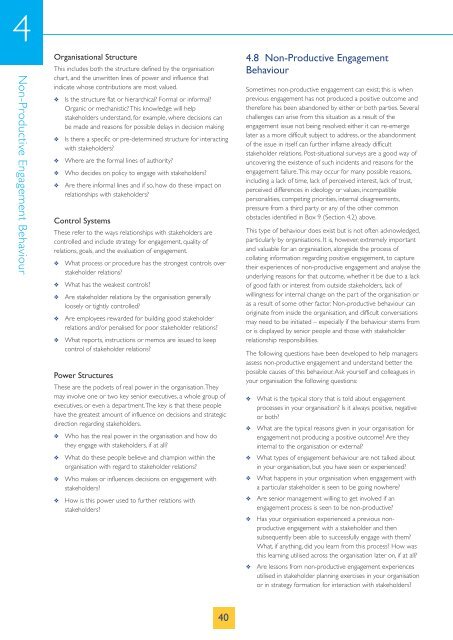Stakeholder Engagement - Cranfield School of Management ...
Stakeholder Engagement - Cranfield School of Management ...
Stakeholder Engagement - Cranfield School of Management ...
Create successful ePaper yourself
Turn your PDF publications into a flip-book with our unique Google optimized e-Paper software.
4<br />
Non-Productive <strong>Engagement</strong> Behaviour<br />
Organisational Structure<br />
This includes both the structure defined by the organisation<br />
chart, and the unwritten lines <strong>of</strong> power and influence that<br />
indicate whose contributions are most valued.<br />
❖ Is the structure flat or hierarchical? Formal or informal?<br />
Organic or mechanistic? This knowledge will help<br />
stakeholders understand, for example, where decisions can<br />
be made and reasons for possible delays in decision making<br />
❖ Is there a specific or pre-determined structure for interacting<br />
with stakeholders?<br />
❖ Where are the formal lines <strong>of</strong> authority?<br />
❖ Who decides on policy to engage with stakeholders?<br />
❖ Are there informal lines and if so, how do these impact on<br />
relationships with stakeholders?<br />
Control Systems<br />
These refer to the ways relationships with stakeholders are<br />
controlled and include strategy for engagement, quality <strong>of</strong><br />
relations, goals, and the evaluation <strong>of</strong> engagement.<br />
❖ What process or procedure has the strongest controls over<br />
stakeholder relations?<br />
❖ What has the weakest controls?<br />
❖ Are stakeholder relations by the organisation generally<br />
loosely or tightly controlled?<br />
❖ Are employees rewarded for building good stakeholder<br />
relations and/or penalised for poor stakeholder relations?<br />
❖ What reports, instructions or memos are issued to keep<br />
control <strong>of</strong> stakeholder relations?<br />
Power Structures<br />
These are the pockets <strong>of</strong> real power in the organisation.They<br />
may involve one or two key senior executives, a whole group <strong>of</strong><br />
executives, or even a department.The key is that these people<br />
have the greatest amount <strong>of</strong> influence on decisions and strategic<br />
direction regarding stakeholders.<br />
❖ Who has the real power in the organisation and how do<br />
they engage with stakeholders, if at all?<br />
❖ What do these people believe and champion within the<br />
organisation with regard to stakeholder relations?<br />
❖ Who makes or influences decisions on engagement with<br />
stakeholders?<br />
❖ How is this power used to further relations with<br />
stakeholders?<br />
40<br />
4.8 Non-Productive <strong>Engagement</strong><br />
Behaviour<br />
Sometimes non-productive engagement can exist; this is when<br />
previous engagement has not produced a positive outcome and<br />
therefore has been abandoned by either or both parties. Several<br />
challenges can arise from this situation as a result <strong>of</strong> the<br />
engagement issue not being resolved: either it can re-emerge<br />
later as a more difficult subject to address, or the abandonment<br />
<strong>of</strong> the issue in itself can further inflame already difficult<br />
stakeholder relations. Post-situational surveys are a good way <strong>of</strong><br />
uncovering the existence <strong>of</strong> such incidents and reasons for the<br />
engagement failure.This may occur for many possible reasons,<br />
including a lack <strong>of</strong> time, lack <strong>of</strong> perceived interest, lack <strong>of</strong> trust,<br />
perceived differences in ideology or values, incompatible<br />
personalities, competing priorities, internal disagreements,<br />
pressure from a third party or any <strong>of</strong> the other common<br />
obstacles identified in Box 9 (Section 4.2) above.<br />
This type <strong>of</strong> behaviour does exist but is not <strong>of</strong>ten acknowledged,<br />
particularly by organisations. It is, however, extremely important<br />
and valuable for an organisation, alongside the process <strong>of</strong><br />
collating information regarding positive engagement, to capture<br />
their experiences <strong>of</strong> non-productive engagement and analyse the<br />
underlying reasons for that outcome, whether it be due to a lack<br />
<strong>of</strong> good faith or interest from outside stakeholders, lack <strong>of</strong><br />
willingness for internal change on the part <strong>of</strong> the organisation or<br />
as a result <strong>of</strong> some other factor. Non-productive behaviour can<br />
originate from inside the organisation, and difficult conversations<br />
may need to be initiated – especially if the behaviour stems from<br />
or is displayed by senior people and those with stakeholder<br />
relationship responsibilities.<br />
The following questions have been developed to help managers<br />
assess non-productive engagement and understand better the<br />
possible causes <strong>of</strong> this behaviour. Ask yourself and colleagues in<br />
your organisation the following questions:<br />
❖ What is the typical story that is told about engagement<br />
processes in your organisation? Is it always positive, negative<br />
or both?<br />
❖ What are the typical reasons given in your organisation for<br />
engagement not producing a positive outcome? Are they<br />
internal to the organisation or external?<br />
❖ What types <strong>of</strong> engagement behaviour are not talked about<br />
in your organisation, but you have seen or experienced?<br />
❖ What happens in your organisation when engagement with<br />
a particular stakeholder is seen to be going nowhere?<br />
❖ Are senior management willing to get involved if an<br />
engagement process is seen to be non-productive?<br />
❖ Has your organisation experienced a previous nonproductive<br />
engagement with a stakeholder and then<br />
subsequently been able to successfully engage with them?<br />
What, if anything, did you learn from this process? How was<br />
this learning utilised across the organisation later on, if at all?<br />
❖ Are lessons from non-productive engagement experiences<br />
utilised in stakeholder planning exercises in your organisation<br />
or in strategy formation for interaction with stakeholders?
















